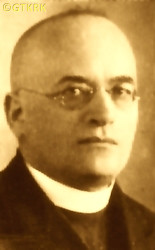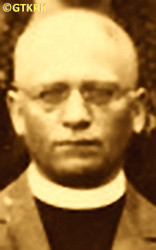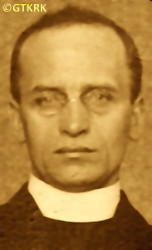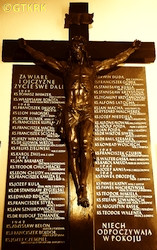Roman Catholic
St Sigismund parish
05-507 Słomczyn
85 Wiślana Str.
Konstancin deanery
Warsaw archdiocese, Poland
full list:
displayClick to display full list

searchClick to search full list by categories
wyświetlKliknij by wyświetlić pełną listę po polsku

szukajKliknij by przeszukać listę wg kategorii po polsku

Martyrology of the clergy — Poland
XX century (1914 – 1989)
personal data
surname
SIWEK
forename(s)
Victor (pl. Wiktor)
function
diocesan priest
creed
Latin (Roman Catholic) Church RCmore on
en.wikipedia.org
[access: 2014.09.21]
diocese / province
Katowice diocesemore on
en.wikipedia.org
[access: 2013.05.19]
Prague archdiocesemore on
en.wikipedia.org
[access: 2014.10.31]
RC Military Ordinariate of Polandmore on
en.wikipedia.org
[access: 2014.12.20]
honorary titles
„Medal of Independence”more on
en.wikipedia.org
[access: 2019.02.02]
(12.05.1931)
Gold „Cross of Merit”more on
en.wikipedia.org
[access: 2019.04.16]
(27.06.1928)
Cross on the Silesian Ribbon of Valor and Merit
(1927)
„Star of Upper Silesia” badge
(1928)
Ten Years of Independence Medalmore on
pl.wikipedia.org
[access: 2019.10.13]
(1929)
War Order of Virtuti Militarimore on
en.wikipedia.org
[access: 2019.10.13]
Badge of the Military Railway Guard
(1927)
date and place
of death
29.12.1941

KL Dachauconcentration camp
today: Dachau, Upper Bavaria reg., Bavaria state, Germany
more on
en.wikipedia.org
[access: 2016.05.30]
details of death
During World War I drafted into German Imperial Army. In 1915‐1918 ministered as chaplain in military hospital of Prussian Army — taking care of Polish POWs in Szczecin, among others.
After the defeat of the Central Powers (Germany and Austria–Hungary) and the end of military operations in World War I, after the simultaneous rebirth of the Polish state, returned to Silesia. There, after the signing of the Versailles Peace Treaty of 28.06.1919, which decided to hold a plebiscite in Upper Silesia to determine the state affiliation of Upper Silesia and the Opole region, after the attempt to annex these regions by the fait accompli method and the fall of the First Silesian Uprising of 16‐24.08.1919, as a sign of protest against further German expansion in Silesia, hung the Polish flag on the hoist shaft of the St Adalbert mine.
From 06.1920, during preparations for a plebiscite, supported Polish cause and actively participated in Polish propaganda efforts.
After German and Russian invasion of Poland in 09.1939 and start of the World War II, after start of German occupation, left Janów.
Captured and arrested by the Germans in Będzin and interrogated.
After release returned to Janów and Szopienice.
Started to organise Polish clandestine independence movement in Szopienice (part of Polish Clandestine State).
Arrested by the Germans again on 07.10.1941.
Jailed in Katowice and EG Myslowitz in Mysłowice prisons.
From there on 13.12.1941 transported to KL Dachau concentration camp where soon perished.
According to the death certificate, prepared in KL Dachau, the „honest” otherwise German „medical doctors” and formalists — and at the same time, unrivaled fairy tale spinners — noted that the cause of death was Germ. „Versagen von Herz und Kreislauf” (Eng. „Heart and circulatory failure”).
prisoner camp's numbers
28882Click to display source page (KL DachauClick to display the description)
cause of death
extermination: exhaustion and starvation
perpetrators
Germans
sites and events
KL DachauClick to display the description, Katowice (prison)Click to display the description, EG MyslowitzClick to display the description, «Intelligenzaktion Schlesien»Click to display the description, «Intelligenzaktion»Click to display the description, Regierungsbezirk KattowitzClick to display the description, Ribbentrop‐MolotovClick to display the description, Pius XI's encyclicalsClick to display the description, Silesian UprisingsClick to display the description
date and place
of birth
05.10.1884Birth certification on:
skanoteka.genealodzy.pl
[access: 2025.04.13]

Szopienicetoday: part of Szopienice‐Burowa district in Katowice, Katowice city pov., Silesia voiv., Poland
more on
en.wikipedia.org
[access: 2022.01.28]
parents
SIWEK Martin
🞲 ?, ? — 🕆 ?, ?

JADWISZCZOK Sophia
🞲 ?, ? — 🕆 ?, ?
presbyter (holy orders)
ordination
05.07.1915

Praguetoday: Prague miasto reg., Czechia
more on
en.wikipedia.org
[access: 2020.07.31]
positions held
1923 – 1941
resident — Janów‐Giszowiectoday: part of districts in Katowice and Mysłowice, Katowice city pov., Silesia voiv., Poland
more on
en.wikipedia.org
[access: 2021.08.11] ⋄ St Anne RC parish ⋄ Mysłowicetoday: Mysłowice city pov., Silesia voiv., Poland
more on
en.wikipedia.org
[access: 2021.04.02] RC deanery
1926 – 1934
director — Szopienicepart known as Roździeń
today: part of Szopienice‐Burowa district in Katowice, Katowice city pov., Silesia voiv., Poland
more on
en.wikipedia.org
[access: 2022.01.28] ⋄ Polish Communal Coeducational gymnasium — first Polish secondary school in Szopienice, translocated from Roździeń
1923 – 1926
prefect — Szopienicetoday: part of Szopienice‐Burowa district in Katowice, Katowice city pov., Silesia voiv., Poland
more on
en.wikipedia.org
[access: 2022.01.28] ⋄ Polish Communal Coeducational gymnasium — founder
activist — religious–national organizations
1923
vicar — Wodzisławtoday: Wodzisław Śląski, Wodzisław Śląski urban gm., Wodzisław Śląski pov., Silesia voiv., Poland
more on
en.wikipedia.org
[access: 2021.12.18] ⋄ Assumption of the Blessed Virgin Mary RC parish
1922
vicar — Chorzówtoday: Roźwienica gm., Jarosław pov., Subcarpathia voiv., Poland
more on
en.wikipedia.org
[access: 2021.12.18] ⋄ RC parish
1921 – 1922
resident — Janów‐Giszowiectoday: part of districts in Katowice and Mysłowice, Katowice city pov., Silesia voiv., Poland
more on
en.wikipedia.org
[access: 2021.08.11] ⋄ St Anne RC parish ⋄ Mysłowicetoday: Mysłowice city pov., Silesia voiv., Poland
more on
en.wikipedia.org
[access: 2021.04.02] RC deanery — primary school prefect
1920
vicar — Mariánské Láznětoday: Cheb dist., Karlovy Vary reg., Czechia
more on
en.wikipedia.org
[access: 2021.12.18] ⋄ RC parish
1919
vicar — Janów‐Giszowiectoday: part of districts in Katowice and Mysłowice, Katowice city pov., Silesia voiv., Poland
more on
en.wikipedia.org
[access: 2021.08.11] ⋄ St Anne RC parish ⋄ Mysłowicetoday: Mysłowice city pov., Silesia voiv., Poland
more on
en.wikipedia.org
[access: 2021.04.02] RC deanery
1919
vicar — Karlovy Varytoday: Karlovy Vary dist., Karlovy Vary reg., Czechia
more on
en.wikipedia.org
[access: 2022.06.29] ⋄ RC parish
1915 – 1918
RC military chaplain — Szczecintoday: Szczecin city pov., West Pomerania voiv., Poland
more on
en.wikipedia.org
[access: 2021.12.18] ⋄ military hospital, Prussian Army, German Imperial Army
1915
vicar — Janów‐Giszowiectoday: part of districts in Katowice and Mysłowice, Katowice city pov., Silesia voiv., Poland
more on
en.wikipedia.org
[access: 2021.08.11] ⋄ St Anne RC parish ⋄ Mysłowicetoday: Mysłowice city pov., Silesia voiv., Poland
more on
en.wikipedia.org
[access: 2021.04.02] RC deanery
student — Maria Enzersdorftoday: Mödling dist., Lower Austria state, Austria
more on
en.wikipedia.org
[access: 2021.12.18] ⋄ philosophy and theology, Higher Theological Seminary in St Gabriel Missionhouse, Verbites SVD
comments
According to sources during World War I ministered as chaplain in the 2nd Prussian Army.
Such however did not exist.
in the Prussian Army there was the 2nd Corps, disbanded though in 01.1915; on the other hand Szczecin was the headquarters of the 3rd Division, which in various larger formations took part in battles on the Eastern Front, and in 1918 also on the Western Front
others related
in death
BARABASZClick to display biography John Nepomucene, CZEMPIELClick to display biography Joseph Matthew, DŁUGOSZClick to display biography Francis Julian, DUDAClick to display biography Erwin, GALOCZClick to display biography Clement, HUWERClick to display biography Joseph, KAŁUŻAClick to display biography Charles, KLIMEKClick to display biography Peter, KORCZOKClick to display biography Anthony Nicodemus, KOSYRCZYKClick to display biography Louis Stanislav, KRZYSTOLIKClick to display biography Stanislav, KRZYŻANOWSKIClick to display biography Sigismund, KULAClick to display biography Joseph, MACHERSKIClick to display biography Francis Emanuel, PAŹDZIORAClick to display biography Augustine, POJDAClick to display biography Adolph, POJDAClick to display biography John, RDUCHClick to display biography Edward, RYGIELSKIClick to display biography Stanislav (Fr Casimir Mary), SZNUROWACKIClick to display biography John, SZRAMEKClick to display biography Emil Michael, ŚCIGAŁAClick to display biography Francis Xavier, WOJCIECHClick to display biography Conrad, WRZOŁClick to display biography Louis Michael, ZIELIŃSKIClick to display biography Felix, ŻMIJClick to display biography Charles, MACIERZYŃSKIClick to display biography Paul Augustine
sites and events
descriptions
KL Dachau: KL Dachau in German Bavaria, set up in 1933, became the main German Germ. Konzentrationslager (Eng. concentration camp) KL for Catholic priests and religious during World War II: On c. 09.11.1940, Reichsführer‐SS Heinrich Himmler, head of the SS, Gestapo and German police, as a result of the Vatican's intervention, decided to transfer all clergymen detained in various concentration camps to KL Dachau camp. The first major transports took place on 08.12.1940. In KL Dachau Germans held approx. 3,000 priests, including 1,800 Poles. The priests were forced to slave labor in the Germ. „Die Plantage” — the largest herb garden in Europe, managed by the genocidal SS, consisting of many greenhouses, laboratory buildings and arable land, where experiments with new natural medicines were conducted — for many hours, without breaks, without protective clothing, no food. They slaved in construction, e.g. of camp's crematorium. In the barracks ruled hunger, freezing cold in the winter and suffocating heat during the summer, especially acute in 1941‐1942. Prisoners suffered from bouts of illnesses, including tuberculosis. Many were victims of murderous „medical experiments” — in 11.1942 c. 20 were given phlegmon injections; in 07.1942 to 05.1944 c. 120 were used by for malaria experiments. More than 750 Polish clerics where murdered by the Germans, some brought to TA Hartheim euthanasia centre set up in Schloss Hartheim in Austria and murdered in gas chambers. At its peak KL Dachau concentration camps’ system had nearly 100 slave labour sub‐camps located throughout southern Germany and Austria. There were c. 32,000 documented deaths at the camp, and thousands perished without a trace. C. 10,000 of the 30,000 inmates were found sick at the time of liberation, on 29.04.1945, by the USA troops… (more on: www.kz-gedenkstaette-dachau.deClick to attempt to display webpage
[access: 2013.08.10], en.wikipedia.orgClick to attempt to display webpage
[access: 2016.05.30])
Katowice (prison): Detention centre run by Germans and later, in 1945, took over by the Commie‐Nazis.
EG Myslowitz: Germ. Polizei Ersatz Gefängnis in Myslowitz (Eng. Police Substitute Prison Mysłowice) was operational from 13.02.1941 till 22.01.1945. Altogether c. 18,000 people went through it, including c. 2,000 women, mainly citizens of the Katowice regency, part of Germ. Provinz Oberschlesien (Eng. Upper Silesia Province) — on average from 100 to 1,200 at any one time. Initially only men were held captive. From 1941 also women were admitted, and from the beginning of 1943 a part of camp was dedicated to underage boys (underage girls were held in women block). Tortures were used. Killings and executions took place. Germans used also the camp to select people for public executions, without a proper court proceedings. Most of the prisoners, including children and teens were subsequently dispatched to concentration and death camps (mainly to nearby KL Auschwitz). (more on: ipn.gov.plClick to attempt to display webpage
[access: 2020.05.25])
«Intelligenzaktion Schlesien»: A planned action of arrests and extermination of Polish Upper Silesia intellectual elite in general recorded in of the so‐called Germ. Sonderfahndungsliste (Eng. Special Wanted List), i.e. a proscription list of names of „enemies of the Reich” — participants of Upper Silesia uprisings, former Polish plebiscite activists, journalists, politicians, intellectuals, civil servants, priests — organised by Germans mainly in 04‐05.1940, aiming at total Germanisation of the region. The relevant decree, no IV‐D2‐480/40, was issued by the RSHA, i.e. Germ. Reichssicherheitshauptamt (Eng. Reich Security Office), and signed by Heinrich Himmler or Reinhard Heydrich. Some of those arrested were murdered in mass executions, some were deported to the German‐run Germ. Generalgouvernement (Eng. General Governorate), and some were sent to concentration camps. The personal details of 3,047 people deported within two months of 1940 were established. Among the victims were 33 Catholic priests, 22 of whom perished in concentration camps (the clergy were sent — in 5 transports — first to KL Dachau, and then to KL Gusen, where they slaved in quarries). Altogether, the Germans murdered c. 2,000 members of the Polish Upper Silesia intellectual elite. (more on: pl.wikipedia.orgClick to attempt to display webpage
[access: 2016.05.30])
«Intelligenzaktion»: German: «Intelligenzaktion» (English: „Intelligence Action”) — a German program of extermination of the Polish elite, mainly the intelligentsia and leadership layers, carried out from the beginning of the occupation in w 09.1939 to 04.1940, mainly in territories directly annexed to Germany, but also in the so‐called Germ. Generalgouvernement (Eng. General Governorate), where it was called «AB‐aktion». In the first phase, immediately after the beginning of the German occupation, during military operations carried out by the Germ. Wehrmacht (Eng. Armed Forces) and the genocidal units of the Germ. Einsatzgruppen (Eng. Operational Groups) of the Germ. Sicherheitspolizei (Eng. Security Police), i.e. SiPo, and Germ. Sicherheitsdienst des Reichsführers SS (Eng. Security Service of the Reichsführer SS), i.e. SD, organized by the Germ. Reichssicherheitshauptamt (Eng. Reich Main Security Office), i.e. RSHA, which followed the troops, carried out under the Germ. Unternehmen „Tannenberg” (Eng. Operation „Tannenberg”) — based on the so‐called Germ. Sonderfahndungsliste (Eng. Special Wanted Lists), i.e. proscription lists of Poles considered particularly dangerous to the Third Reich, prepared by the Zentralstelle II/P (Polen) unit of the German RSHA. Later, implemented by the German civilian occupation authorities and the genocidal unit of the Germ. Volksdeutscher Selbstschutz (Eng. Ethnic Germans Self‐Defense), whose members were Germ. Volksdeutsche (Eng. Ethnic Germans), i.e. representatives of the German minority in Poland. According to various sources, these lists, at the beginning of 09.1939, could have contained the details of 61,000—88,000 „dangerous” Poles — although these figures cannot be confirmed. In total, during this genocide, c. 50,000 teachers, Catholic priests, representatives of the landed gentry, freelancers, social and political activists, and retired military personnel were systematically and methodically murdered. Another 50,000 were sent to concentration camps, where only a negligible percentage survived. (more on: en.wikipedia.orgClick to attempt to display webpage
[access: 2014.10.04])
Regierungsbezirk Kattowitz: After the Polish defeat in the 09.1939 campaign, which was the result of the Ribbentrop‐Molotov Pact and constituted the first stage of World War II, and the beginning of German occupation in part of Poland (in the other, eastern part of Poland, the Russian occupation began), the Germans divided the occupied Polish territory into five main regions (and a few smaller). The largest one was transformed into Germ. Generalgouvernement (Eng. General Governorate), intended exclusively for Poles and Jews and constituting part of the so‐called Germ. Großdeutschland (Eng. Greater Germany). From two separate new provinces were created. The two remaining were incorporated into existing German provinces. One of those was Polish Upper Silesia, which on 08.09.1939, by decree of the German leader Adolf Hitler (formally came into force on 26.10.1939), was incorporated into Germany as the Germ. Regierungsbezirk Kattowitz (Eng. Katowice Regency) and became part of the Germ. Provinz Schlesien (Eng. Province of Silesia) based in Wrocław. On 01.04.1940, the Germ. Regierungsbezirk Kattowitz was enlarged by several pre‐war German counties, and on 18.01.1941, a new German province was created, the Germ. Provinz Oberschlesien (Eng. Province of Upper Silesia), which, apart from the Germ. Regierungsbezirk Kattowitz, also included the Opole region. From 26.10.1939, when the regency was established, the law of the German state was in force there, the same as in Berlin. The main axis of the policy of the new regency, the territory of which the Germans recognized as the Germ. „Ursprünglich Deutsche” (Eng. „natively German”), despite the fact only 6% of its pre–war Polish part were Germans, was Germ. „Entpolonisierung” (Eng. „Depolonisation”), i.e. forced Germanization. The main mechanism was the introduction of the Germ. Deutsche Volksliste DVL, a German nationality list that was supposed to specify the national affiliation of the inhabitants of the region. The largest group marked in the compulsory registrations was Group 3, people who identified themselves as „Silesians” (in 1943 about 41%), and people remaining outside the DVL (about 36%). The latter group was intended to be deported to the Germ. Generalgouvernement (which did not happen en masse because German industry needed slave labor). Group 3, considered by the Germans as capable of Germanization, was subject to certain legal restrictions, and was subject to, among others, to conscription into the German Wehrmacht army. Children could only learn in German. A policy of terror was pursued against the Polish population. There was a special police court, controlled by the Germ. Geheime Staatspolizei (Eng. Secret State Police), i.e. the Gestapo, before which c. 4,000‐5,000 people were detained. For the years 1942‐1945 over 2,000 of them were verified, of which 1,890 were sentenced to death, including 286 in public executions. Thousands of people were murdered during the so‐called «Intelligenzaktion Schlesien», including 300‐650 Polish teachers and c. 61 Polish Catholic priests. The regency hosted a German concentration and extermination camp KL Auschwitz, where the Germans imprisoned c. 1,100,000 Jews (murdering c.1,000,000, i.e. c. 90% of them) and c. 140,000 Poles (murdering c. 70,000, i.e. c. 50% of them). After the end of hostilities of World War II, the overseer of this province, the Germ. Reichsstatthalter (Eng. Reich Governor) and the Germ. Gauleiter (Eng. district head) of the German National Socialist Party, Fritz Brecht, committed suicide. (more on: en.wikipedia.orgClick to attempt to display webpage
[access: 2024.06.24])
Ribbentrop‐Molotov: Genocidal Russian‐German alliance pact between Russian leader Joseph Stalin and German leader Adolf Hitler signed on 23.08.1939 in Moscow by respective foreign ministers, Mr. Vyacheslav Molotov for Russia and Joachim von Ribbentrop for Germany. The pact sanctioned and was the direct cause of joint Russian and German invasion of Poland and the outbreak of the World War II in 09.1939. In a political sense, the pact was an attempt to restore the status quo ante before 1914, with one exception, namely the „commercial” exchange of the so‐called „Kingdom of Poland”, which in 1914 was part of the Russian Empire, fore Eastern Galicia (today's western Ukraine), in 1914 belonging to the Austro‐Hungarian Empire. Galicia, including Lviv, was to be taken over by the Russians, the „Kingdom of Poland” — under the name of the General Governorate — Germany. The resultant „war was one of the greatest calamities and dramas of humanity in history, for two atheistic and anti‐Christian ideologies — national and international socialism — rejected God and His fifth Decalogue commandment: Thou shall not kill!” (Abp Stanislav Gądecki, 01.09.2019). The decisions taken — backed up by the betrayal of the formal allies of Poland, France and Germany, which on 12.09.1939, at a joint conference in Abbeville, decided not to provide aid to attacked Poland and not to take military action against Germany (a clear breach of treaty obligations with Poland) — were on 28.09.1939 slightly altered and made more precise when a treaty on „German‐Russian boundaries and friendship” was agreed by the same murderous signatories. One of its findings was establishment of spheres of influence in Central and Eastern Europe and in consequence IV partition of Poland. In one of its secret annexes agreed, that: „the Signatories will not tolerate on its respective territories any Polish propaganda that affects the territory of the other Side. On their respective territories they will suppress all such propaganda and inform each other of the measures taken to accomplish it”. The agreements resulted in a series of meeting between two genocidal organization representing both sides — German Gestapo and Russian NKVD when coordination of efforts to exterminate Polish intelligentsia and Polish leading classes (in Germany called «Intelligenzaktion», in Russia took the form of Katyń massacres) where discussed. Resulted in deaths of hundreds of thousands of Polish intelligentsia, including thousands of priests presented here, and tens of millions of ordinary people,. The results of this Russian‐German pact lasted till 1989 and are still in evidence even today. (more on: en.wikipedia.orgClick to attempt to display webpage
[access: 2015.09.30])
Pius XI's encyclicals: Facing the creation of two totalitarian systems in Europe, which seemed to compete with each other, though there were more similarities than contradictions between them, Pope Pius XI issued in 03.1937 (within 5 days) two encyclicals. In the „Mit brennender Sorge” (Eng. „With Burning Concern”) published on 14.03.1938, condemned the national socialism prevailing in Germany. The Pope wrote: „Whoever, following the old Germanic‐pre‐Christian beliefs, puts various impersonal fate in the place of a personal God, denies the wisdom of God and Providence […], whoever exalts earthly values: race or nation, or state, or state system, representatives of state power or other fundamental values of human society, […] and makes them the highest standard of all values, including religious ones, and idolizes them, this one […] is far from true faith in God and from a worldview corresponding to such faith”. On 19.03.1937, published „Divini Redemptoris” (Eng. „Divine Redeemer”), in which criticized Russian communism, dialectical materialism and the class struggle theory. The Pope wrote: „Communism deprives man of freedom, and therefore the spiritual basis of all life norms. It deprives the human person of all his dignity and any moral support with which he could resist the onslaught of blind passions […] This is the new gospel that Bolshevik and godless communism preaches as a message of salvation and redemption of humanity”… Pius XI demanded that the established human law be subjected to the natural law of God , recommended the implementation of the ideal of a Christian state and society, and called on Catholics to resist. Two years later, National Socialist Germany and Communist Russia came together and started World War II. (more on: www.vatican.vaClick to attempt to display webpage
[access: 2023.05.28], www.vatican.vaClick to attempt to display webpage
[access: 2023.05.28])
Silesian Uprisings: Three armed interventions of the Polish population against Germany in 1919‐1921 aiming at incorporation of Upper Silesia and Opole region into Poland, after the revival of the Polish state in 1918. Took place in the context of a plebiscite ordered on the basis of the international treaty of Versailles of 28.06.1919, ending the First World War, that was to decide national fate of the disputed lands. The 1st Uprising took place on 16‐24.08.1919 and broke out spontaneously in response to German terror and repression against the Polish population. Covered mainly Pszczyna and Rybnik counties and part of the main Upper Silesia industrial district. Suppressed by the Germans. 2nd Uprising took place on 19‐25.08.1920 in response to numerous acts of terror of the German side. Covered the entire area of the Upper Silesia industrial district and part of the Rybnik county. As a result Poles obtained better conditions for the campaign prior the plebiscite. The poll was conducted on 20.03.1921. The majority of the population — 59.6% — were in favor of Germany, but the results were influenced by the admission of voting from former inhabitants of Upper Silesia living outside Silesia. As a result the 3rd Uprising broke out, the largest such uprising of the Silesian in the 20th century. It lasted from 02.05.1921 to 05.07.1921. Spread over almost the entire area of Upper Silesia. Two large battles took place in the area of St. Anna Mountain and near Olza. As a result on 12.10.1921 the international plebiscite commission decided on a more favorable for Poland division of Upper Silesia. The territory granted to Poland was enlarged to about ⅓ of the disputed territory. Poland accounted for 50% of metallurgy and 76% of coal mines. (more on: en.wikipedia.orgClick to attempt to display webpage
[access: 2020.05.25])
sources
personal:
silesia.edu.plClick to attempt to display webpage
[access: 2019.10.13], skanoteka.genealodzy.plClick to attempt to display webpage
[access: 2025.04.13]
bibliographical:
„International Tracing Service (ITS), Bad Arolsen, GermanyClick to display source page”, Arolsen Archives
original images:
bsip.miastorybnik.plClick to attempt to display webpage
[access: 2020.05.25], szopienice.plClick to attempt to display webpage
[access: 2022.05.23]
LETTER to CUSTODIAN/ADMINISTRATOR
If you have an Email client on your communicator/computer — such as Mozilla Thunderbird, Windows Mail or Microsoft Outlook, described at WikipediaPatrz:
en.wikipedia.org, among others — try the link below, please:
LETTER to CUSTODIAN/ADMINISTRATORClick and try to call your own Email client
If however you do not run such a client or the above link is not active please send an email to the Custodian/Administrator using your account — in your customary email/correspondence engine — at the following address:

giving the following as the subject:
MARTYROLOGY: SIWEK Victor
To return to the biography press below:
 Click to return to biography
Click to return to biography












